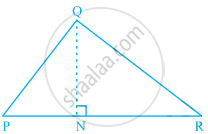Advertisements
Advertisements
Question
If the coordinates of the mid-points of the sides of a triangle are (3, 4) (4, 6) and (5, 7), find its vertices.
Solution
The co-ordinates of the midpoint `(x_m,y_m)` between two points `(x_1,y_1)` and (x_2,) is given by,
`(x_m,y_m) = (((x_1+x_2)/2)"," ((y_1+y_2)/2))`
`Let the three vertices of the triangle be `A(x_A,y_A), B(x_B, y_B)` and `C(x_C, y_C)`.
The three midpoints are given. Let `these points be `M_(AB)` (3,4), `M_(BC)` (4, 6)`and `M_(CA) (5, 7)`.
Let us now equate these points using the earlier mentioned formula,
`(3,4) = (((x_A + x_B)/2)"," ((y_A + y_B)/2))`
Equating the individual components we get,
`x_A + x_B = 6`
`y_A + y_B = 8`
Using the midpoint of another side we have,
`(4,6) = (((x_B + x_C)/2)","((y_B + y_C)/2))`
Equating the individual components we get,
`x_B + x_C = 8`
`y_B + y_C = 12`
Using the midpoint of the last side we have,
`(5,7) = (((x_A + x_C)/2)","((y_A + y_C)/2))`
Equating the individual components we get,
`x_A + x_C = 10`
`y_A + y_C = 14`
Adding up all the three equations which have variable ‘x’ alone we have,
`x_A + x_B + x_B + x_C + x_A + x_C = 6 + 8 + 10`
`2(x_A + x_B + x_C) = 24`
`x_A + x_B + x_C = 12`
Substituting `x_B + x_C = 4` in the above equation we have,
`x_A + x_B + x_C = 12`
`x_A + 8 = 12`
`x_A = 4`
Therefore,
`x_A + x_C = 10`
`x_C = 10 - 4`
`x_C = 6`
And
`x_A + x_B = 6`
`x_B = 6 - 4`
`x_B = 2`
Adding up all the three equations which have variable ‘y’ alone we have,
`y_A + y_B + y_B + y_C + y_A + y_C = 8 + 12 + 14`
`2(y_A + y_B + y_C) = 34`
`y_A + y_B + y_C = 17`
Substituting `y_B + y_C = 12` in the above equation we have
`y_A + y_B + y_C = 17`
`y_A + 12 = 17`
`y_A = 5`
Therefore
`y_A + y_C = 14`
`y_C = 14 - 5`
`y_C = 9
And
`y_A + y_B = 8`
`y_C = 14 - 5`
`y_C = 9`
And
`y_A + y_B = 8`
`y_B = 8 - 5`
`y_B = 3`
Therefore the co-ordinates of the three vertices of the triangle are A(4,5), B(2,3), C(6,9)
APPEARS IN
RELATED QUESTIONS
If A(−4, 8), B(−3, −4), C(0, −5) and D(5, 6) are the vertices of a quadrilateral ABCD, find its area.
Find the area of the triangle PQR with Q(3,2) and the mid-points of the sides through Q being (2,−1) and (1,2).
Find a relation between x and y if the points (x, y), (1, 2) and (7, 0) are collinear.
Using integration, find the area of the triangle whose vertices are (2, 3), (3, 5) and (4, 4).
If the points (3, -2), (x, 2), (8, 8) are collinear, then find the value of x.
Points A(–6, 10), B(–4, 6) and C(3, –8) are collinear such that AB = `2/9` AC.
Find the coordinates of the point Q on the x-axis which lies on the perpendicular bisector of the line segment joining the points A(–5, –2) and B(4, –2). Name the type of triangle formed by the points Q, A and B.
Find the area of the triangle whose vertices are (–8, 4), (–6, 6) and (–3, 9).
A rectangular plot is given for constructing a house, having a measurement of 40 m long and 15 m in the front. According to the laws, a minimum of 3 m, wide space should be left in the front and back each and 2 m wide space on each of other sides. Find the largest area where house can be constructed.
Area of triangle PQR is 100 cm2 as shown in the below figure. If altitude QT is 10 cm, then its base PR is ______.

